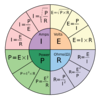-
Categories
-
Platforms
-
Content
You are using an out of date browser. It may not display this or other websites correctly.
You should upgrade or use an alternative browser.
You should upgrade or use an alternative browser.
Scroll to continue with content
bertus
Moderator
But it will heat up. Even if only a few milli-Celsius -> power dissipation -> wasteIf you pick the right resistance it wont heat up as much
A dead short is one "of the pathways just leads back to the battery again". It wastes ALL the battery's power.
A series resistance wastes power.
A series resistance and a resistance to ground (in a voltage divider) has both resistors wasting power.
A series resistor and a voltage divider produce very poor voltage regulation.
A series resistance wastes power.
A series resistance and a resistance to ground (in a voltage divider) has both resistors wasting power.
A series resistor and a voltage divider produce very poor voltage regulation.
Sorry, not sure where you were wanting to go with this, but have you looked into working out the resistive load (possible equivalent to the work you want done) on something that maximises the power transferred.
Maximum power transfer theorem.
https://en.wikipedia.org/wiki/Maxim... the maximum,viewed from its output terminals.
Maximum power transfer theorem.
https://en.wikipedia.org/wiki/Maxim... the maximum,viewed from its output terminals.
All I really meant was something basic, that the junction leading to negative/ground with the resistor, will take no current at all, it all goes down the short, and the voltage reduction transformation is 99% perfect, the rest stays in the battery fine and it develops less heat because of it.

And if you add a bypass cap to it, you can reduce the resistance to 0, what goes into your device.

And if you add a bypass cap to it, you can reduce the resistance to 0, what goes into your device.
When you short the resistor then there is no voltage divider and there is no load.
Thats a picture of a voltage divider is it not?
It still works, but R1 and R2 have to be high value resistors, higher than the load, so it reduces current and voltage, and the more resistive the load the more it wastes as it equalizes with the R2 resistor.
But I need to look at it further, there might be a way it can work! =)
Maybe if u add a spark gap separation, it could work, but ud need high voltage.... and erm... havent i reduced voltage...

Yes its made a single pole filter, but its only dc going into it.
But I need to look at it further, there might be a way it can work! =)
Maybe if u add a spark gap separation, it could work, but ud need high voltage.... and erm... havent i reduced voltage...

Yes its made a single pole filter, but its only dc going into it.
Last edited:
Why do you have a useless high voltage spark gap powered from expensive high voltage resistors that reduce the voltage?
What high voltage load do you have that uses an expensive high voltage capacitor parallel with it to filter away current pulses created by the spark gap?
How will you prevent the spark from causing radio, TV and communications interference?
60 years ago I made a blinking light chaser with a 90V battery and some neon light bulbs, each bulb with a series resistor and a capacitor to ground. the neon bulb was in parallel with the capacitor. The series resistor allowed the capacitor to charge slowly then when the 60V threshold voltage of the neon bulb was reached it conducted and lighted, discharging the capacitor then it would repeat as an oscillator. The neon bub produced no interference.
Today low voltage LEDs and logic ICs are used to make RC oscillators and sequencers.
What high voltage load do you have that uses an expensive high voltage capacitor parallel with it to filter away current pulses created by the spark gap?
How will you prevent the spark from causing radio, TV and communications interference?
60 years ago I made a blinking light chaser with a 90V battery and some neon light bulbs, each bulb with a series resistor and a capacitor to ground. the neon bulb was in parallel with the capacitor. The series resistor allowed the capacitor to charge slowly then when the 60V threshold voltage of the neon bulb was reached it conducted and lighted, discharging the capacitor then it would repeat as an oscillator. The neon bub produced no interference.
Today low voltage LEDs and logic ICs are used to make RC oscillators and sequencers.
Ratstar, if your not talking about high voltage, a voltage follower circuit is probably what your after.
You can use a voltage divider with high resistance (low power loss) to feed it with your desired voltage, and still have adequate power output to feed your load.
http://www.learningaboutelectronics... (also called,any amplification to the signal.
You can use a voltage divider with high resistance (low power loss) to feed it with your desired voltage, and still have adequate power output to feed your load.
http://www.learningaboutelectronics... (also called,any amplification to the signal.
Similar threads
- Replies
- 4
- Views
- 1K
- Replies
- 4
- Views
- 2K
- Replies
- 40
- Views
- 4K
- Replies
- 11
- Views
- 1K
- Replies
- 25
- Views
- 3K


